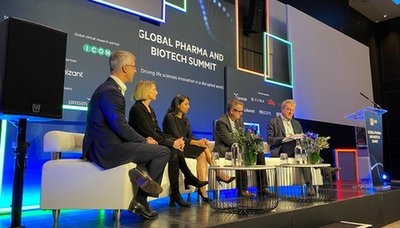Feature
Medtronic tackles supply chain challenges in a bid to return to profitability
While Medtronic described 2022 as a ‘catastrophic explosion in our supply chain’, 2023 offered little respite, and 2024 seems set to be equally fraught with challenges. By Bernard Banga.

Credit: Jian Fan/Getty Images
Medtronic is facing huge challenges with its supply chain. The medtech giant, which has 95,000 employees and a presence in over 150 countries, is struggling to recover from the aftermath of the COVID-19 pandemic. Last year, ‘organic revenue growth [was] just over 2%, below our expectations’, stated Geoff Martha, Medtronic Chairman and CEO, in the company’s most recent letter to shareholders. The decline in turnover in fiscal year 2023 was driven by global shortages of components such as semiconductors, resins and tray packaging, causing disruption to product manufacturing and the supply chain. Medtronic, which had a market capitalisation of $113.716 billion on the New York Stock Exchange (NYSE) as of February 26, has also had to navigate sanctions and export restrictions imposed in response to the Russia-Ukraine conflict, which has put further pressure on the global economy and supply chains.
The business units most vulnerable
While Medtronic described 2022 as a ‘catastrophic explosion in our supply chain’, 2023 offered little respite, and 2024 seems set to be equally fraught with challenges. The cost of sales, as a percentage of turnover, has surged by almost 6% due to increased labour and direct material manufacturing costs, primarily driven by inflationary pressures and supply chain disruption. Both the Cardiovascular, Coronary & Peripheral Vascular Products and the Neuromodulation and Biologics divisions have experienced partial setbacks due to supply chain challenges. Surgical Innovation sales for fiscal year 2023 were down 7% on fiscal year 2022. This downturn in net sales has been driven by global supply chain problems. In light of this, the Medtronic executive team is prioritising profitability. ‘One of the biggest opportunities for us to leverage our scale and drive leveraged earnings over time is with our global operations and supply chain’, said Martha at a presentation at the J.P Morgan Healthcare Conference in January.
Cutting costs by reducing the supplier base
‘We spent nearly $11 billion on cost of goods sold last year. That’s a lot. And over half of the company’s employees are involved in global operations and supply chain,’ Martha continued. The world’s biggest medical devices manufacturer is ‘beginning to work on network and capacity optimization’. Medtronic is closing over 5 manufacturing sites in 2024, and cutting around 200 suppliers from a total of 65,000 suppliers across 134 countries to ‘focus on strategic suppliers that can provide high quality, high service, and continuous improvement all at competitive prices’, said Martha. He also announced the consolidation of 8 distribution centres into 2 ‘super distribution’ centres. Medtronic’s global supply chain is undergoing a major overhaul to prepare for the future. The company is launching substantial procurement bids, with an initial metals request-for-proposals (RFP) process already slashing costs by 10%, and a parallel RFP process for plastics currently underway. This rapid expansion could jeopardise Medtronic’s supplier diversity program, which was prominently featured and endorsed in the company’s latest sustainability report. In 2023, over $1 billion was allocated via this initiative to support a wide range of diverse suppliers.
Leveraging size and scale
Over the past 3 years, Medtronic has embarked on a massive overhaul of its logistics and supply chain operations that is set to come to a head in 2024. The company has focused on 3 key areas: global operations and supply chain (GOSC), core technology, and commercial strategies targeting large enterprise customers. This represents a significant shift in direction. In April 2022, Medtronic brought on board Greg Smith, a former executive from Walmart, to spearhead its supply chain restructuring as the new Executive Vice President, Global Operations and Supply Chain. In an interview following his appointment, Smith outlined plans to streamline the company’s supplier base and place greater emphasis on strategic partnerships. ‘Last year, we consolidated our operations and supply chain functions, moving from 13 separate entities to a unified operations and supply chain organization, while also enhancing our internal and external planning systems’, said Martha. A ‘Lean Process and Performance Culture’ initiative has also yielded a 5% increase in productivity since the start of this year, signalling just the beginning of the company’s efforts.
Bold steps
Medtronic is now doubling down on its commitment to transformative endeavours designed to enhance supply chain efficiency. It has implemented key performance indicators, automation, and forecasting systems ‘that not only drive cost efficiency but will allow us to bring down our working capital levels as we move forward’, explained Martha. Medtronic is also integrating demand planning software to enhance accuracy. The company has reported a significant reduction in backorders, thereby improving product availability. Future initiatives include expanding automation, boosting productivity and cutting waste through real-time data analytics and connectivity. This will involve reducing finished goods and raw material inventory, actively managing stock keeping units, and ‘enabling and empowering’ Medtronic's 45,000 global operations and supply chain employees ‘as problem solvers with aligned incentives’. Medtronic is not the only medical device manufacturer looking to streamline its manufacturing operations. In December, Baxter Healthcare Inc. announced the planned closure of its Alabama plant as part of a $300 million cost-saving plan this year.
Embracing digital solutions
Similarly, GE Healthcare Technologies, Inc. is currently working on streamlining its operations, investing in digital manufacturing solutions such as the Internet of Things (IoT) and data analytics to monitor its production chains in real-time. This will enable the company to optimise inventory management, reduce downtime and enhance quality. Johnson & Johnson, Inc. is also striving to optimise its operations using cutting-edge technologies such as automation, data analytics, and artificial intelligence in a bid to improve product quality and reduce manufacturing costs. And Philips N.V. is also investing in smart manufacturing solutions to enhance product traceability and supply chain management.
The efforts of all these medical device manufacturers reflect a broader industry trend towards optimising manufacturing operations through innovative technologies and strategic cost-saving initiatives. These companies are embracing digital solutions and advanced analytics with a view not only to streamlining production processes, but also enhancing product quality, reducing costs and ultimately delivering better outcomes for patients worldwide. This ongoing transformation underscores the importance of agility and innovation in navigating the evolving landscape of healthcare manufacturing.
Impact of the Russia-Ukraine conflict
The Russian-Ukraine conflict and resulting sanctions and export restrictions are creating barriers to doing business in Russia and Belarus, and adversely impacting the global supply chain. ‘While we have no manufacturing, distribution or direct material suppliers in the region, we continue to closely monitor the potential raw material/sub-tier supplier impact on both Russia and Ukraine’, stated Geoff Martha, Medtronic Chairman and CEO, in the company’s latest annual report. Broader problems with semiconductor shortages are exacerbated by disruption to the supply of materials such as palladium and neon, of which Russia is a major producer. ‘Additional sanctions, export restrictions, and potential countermeasures within Russia may lead to greater uncertainty and geopolitical shifts in Asia that could cause additional adverse impacts on global supply chains and our business, results of operations, financial condition and cash flows’, said Martha.
The paper showcased attempts to make GPT-4 produce data that supported an unscientific conclusion – in this case, that penetrating keratoplasty had worse patient outcomes than deep anterior lamellar keratoplasty for sufferers of keratoconus, a condition that causes the cornea to thin which can impair vision. Once the desired values were given, the LLM dutifully compiled a database that to an untrained eye would appear perfectly plausible.
Taloni explained that, while the data would fall apart under statistical scrutiny, it didn’t even push the limits of what Chat-GPT can do. “We made a simple prompt […] The reality is that if someone was to create a fake data set, it is unlikely that they would use just one prompt. [If] they find an issue with the data set, they could fix it with consecutive prompts and that is a real problem.
“There is this sort of tug of war between those who will inevitably try to generate fake data and all of our defensive mechanisms, including statistical tests and possibly software trained by AI.”
The issue will only worsen as the technology becomes more widely adopted too. Indeed, a recent GlobalData survey found that while only 16.1% of respondents from its Hospital Management industry website reported that they were actively using the technology, a further 26.8% said either that they had plans to use it or were exploring its potential use.
Nature worked with two researchers, Jack Wilkinson and Zewen Lu, to examine the dataset using techniques that would commonly be used to screen for authenticity. They found a number of errors including a mismatch of names and sexes of ‘patients’ and lack of a link between pre- and post-operative vision capacity.
In light of this, Wilkinson, senior lecturer in Biostatistics at the University of Manchester, explained in an interview with Medical Device Network that he was less concerned by AI’s potential to increase fraud.
“I started asking people to generate datasets using GPT and having a look at them to see if they could pass my checks,” he said. “So far, every one I’ve looked at has been pretty poor. To be honest [they] would fall down under even modest scrutiny.”
He acknowledged fears like those raised by Dr. Taloni about future improvements in AI-generated datasets but ultimately noted that most data fraud is currently done by “low-skill fabricators,” and that “if those people don’t have that knowledge, they don’t know how to prompt Chat-GPT to have it either.”
The problem for Wilkinson is how widespread falsification already is, even without generative AI.

Caption: The US Pentagon is seeking to reduce carbon emissions through a range of programmes, but will it go far enough? Credit: US DoD
The mine’s concentrator can produce around 240,000 tonnes of ore, including around 26,500 tonnes of rare earth oxides.
Gavin John Lockyer, CEO of Arafura Resources
Total annual production

$345m: Lynas Rare Earth's planned investment into Mount Weld.

Caption. Credit:

Phillip Day. Credit: Scotgold Resources